#waptia
Explore tagged Tumblr posts
Text

sick and tired of inaccurate anomalocaris paleoart ,, decided to take matters into my own hands
#this is my first time doing sum like this idk😓😓#anomalocaris#anomalopost#opabinia#hallucigenia#waptia#radiodonta#radiodont#cambrian#cambrian period#cambrian explosion#paleozoic#paleontology#paleoart#paleo#rave art
588 notes
·
View notes
Text







Waptia fieldensis
(temporal range: 510-505 mio. years ago)
[text from the Wikipedia article, see also link above]
Waptia is an extinct genus of arthropod from the Middle Cambrian of North America. It grew to a length of 6.65 cm (3 in), and had a large bivalved carapace and a segmented body terminating into a pair of tail flaps. It was an active swimmer and likely a predator of soft-bodied prey. It is also one of the oldest animals with direct evidence of brood care. Waptia fieldensis is the only species classified under the genus Waptia, and is known from the Burgess Shale Lagerstätte of British Columbia, Canada. Specimens of Waptia are also known from the Spence Shale of Utah, United States.
Based on the number of individuals, Waptia fieldensis is the third most abundant arthropod from the Burgess Shale Formation, with thousands of specimens collected. It was among the first fossils found by the American paleontologist Charles D. Walcott in 1909. He described it in 1912 and named it after two mountains near the discovery site – Wapta Mountain and Mount Field, other specimens
Although it bears a remarkable resemblance to modern crustaceans, its taxonomic affinities were long unclear. A comprehensive redescription published 2018 classified it a member of Hymenocarina (which contains numerous other bivalved arthropods) within Mandibulata.
9 notes
·
View notes
Text
[Image description: An art piece of four Cambrian arthropods — Anomalocaris, Aegirocassis, Waptia, and Opabinia — stylized similarly to Littlest Pet Shop toys, with bright colours, rounded shiny shapes, and large eyes with highlights.
The Anomalocaris is purple with little star markings, and has teal eyes with heart-shaped highlights. The Aegirocassis is pink with little heart markings, and has orange eyes (only one visible) with a star-shaped highlight. The Waptia is orange with crescent markings, and has teal eyes with four-petal flower-shaped highlights. Finally, the Opabinia is teal with four-petal flower markings, and has purple eyes with crescent highlights.
The words “CAMBRIAN CUTIES” are written above them in shiny teal and pink letters. In smaller white letters to the upper left and lower right is a tagline: “Collect Em All… …Before They’re Gone!”
End ID.]
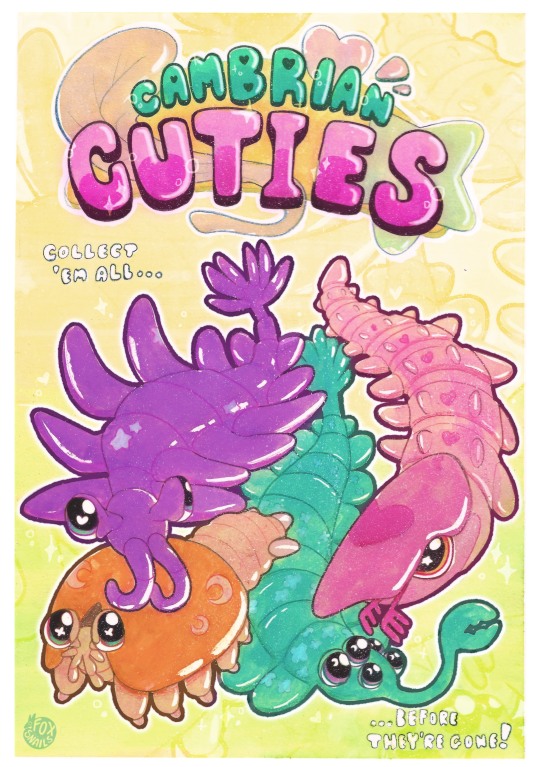
Remember these guys? I had the whole collection back in 538 Million BC 💜🦑
#paleontology#Paleozoic#Cambrian#animals#arthropods#dinocarids#Radiodonta#Opabiniidae#Hymenocarina#Anomalocaris#Aegirocassis#Waptia#Opabinia#cute#cool art
3K notes
·
View notes
Text


waptia-tan from cambrian qts
108 notes
·
View notes
Text
Cambrian wallpapers, just for fun! Who doesnt like like dinosaur shrimps?
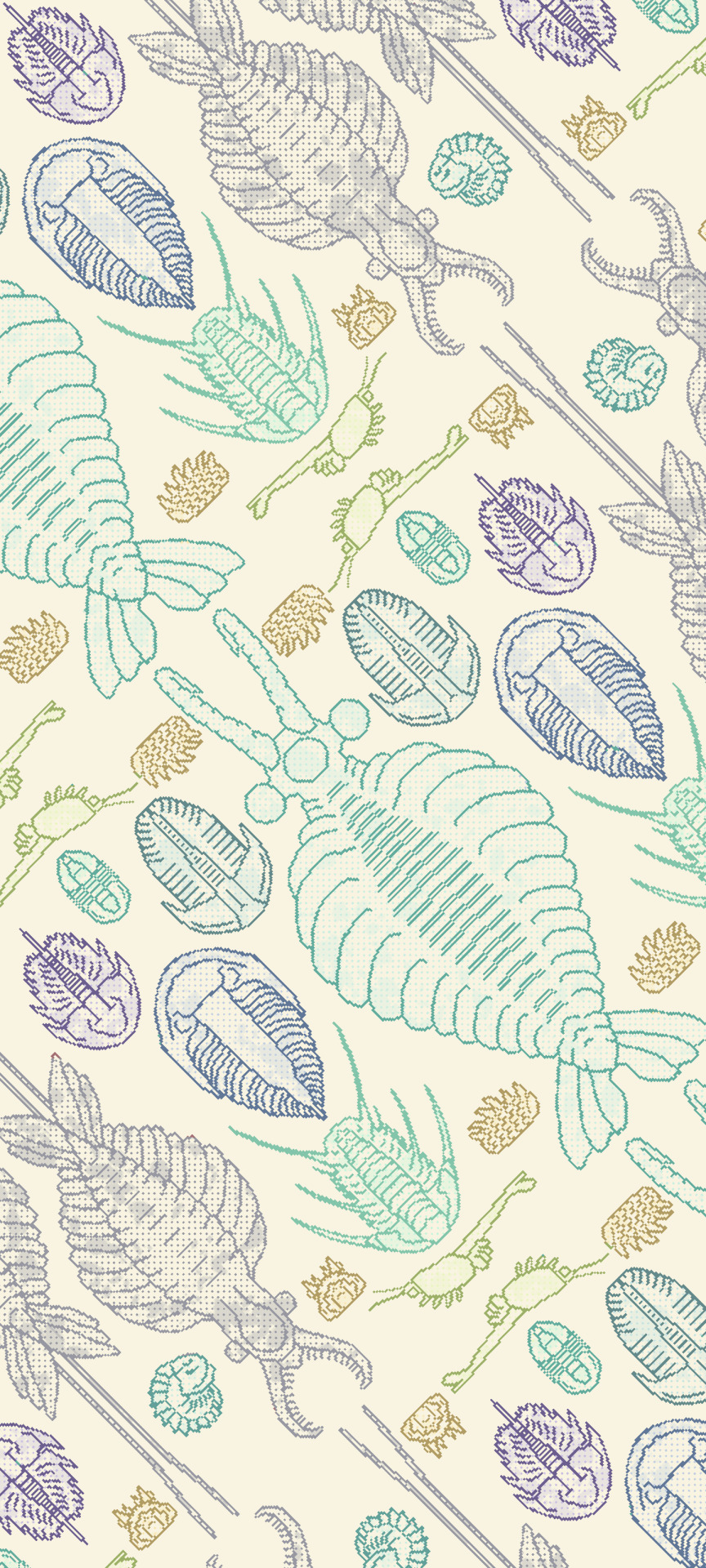

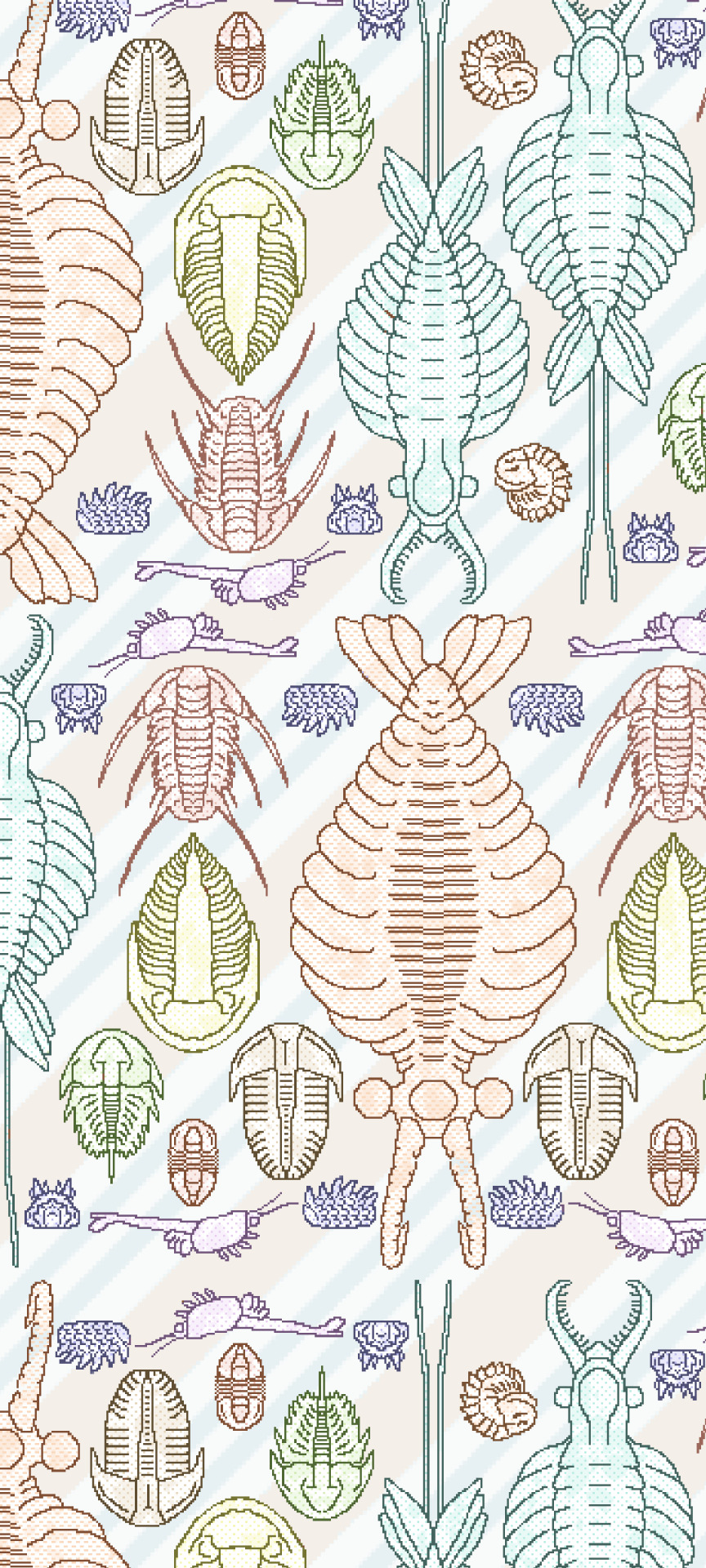
852 notes
·
View notes
Note
for the doodle requests - some creatures from the Cambrian explosion!

Cambrian queers -the big anomalicaris, she’s Karen.
#idk what to caption this#TY FOR THE ASKK#doodle#sketch#my art#traditional art#paleoart#anomalicaris#waptia#opabinia#hallucigenia#mailbox✉️
51 notes
·
View notes
Photo

A FIELD GUIDE TO CAMBRIAN FAUNA is part of a series of zines about prehistoric life. A mix of illustration, speculation and science, this second volume contains 50+ pages as well as 20 full-color illustrations.
How you can support the project:
Purchase the 1st volume here! (limited supply)
Reblog/like/spread the word!
32 notes
·
View notes
Photo

This taco is called Waptia. I liked my practice version better than the final, but WHAT CAN YA DO.
#evolution#Cambrianperiod#Cambrian#extinctanimals#seacreatures#watercolor#drawing#waptia#sketch#Illustration
1 note
·
View note
Text

Opabinia and Anomalocaris looking festive for the holidays. And a school of Waptia doing their impression of a string of Christmas lights.
Available as a print and cards on my Redbubble shop:
19 notes
·
View notes
Text

Last post on the series “Life Finds a Way,” this post has creatures from the letters W to Z + bonus. The rest of the series can be seen here: Part 1, 2, 3, 4, 5 and 6
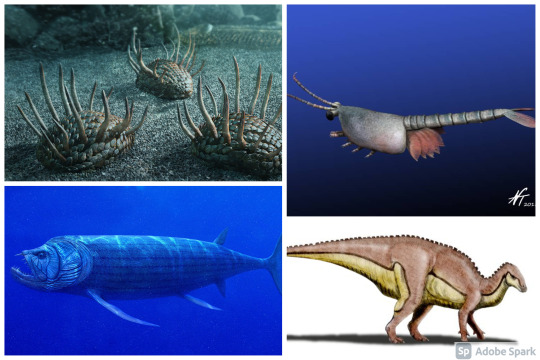
1. Wiwaxia (Top left) Genus*: Wiwaxia. Time: Cambrian- Ordovician (520-505 mya). Length: 5 centimetres (2.0 in). Weight: Since most animals from this era were soft bodied creatures with a chitinous/carbonaceous protection, all we have in fossil records are just imprints left on the rocks. It is very difficult to estimate the weight of these creatures.
2. Waptia (Top right) Genus: Waptia. Time: Middle Cambrian (509-497 mya). Length: 8 centimetres (3.1 in). Weight: Look above.
3. Xiphactinus (Bottom left) Genus: Bony predatory fish. Time: Early to late Cretaceous (112-66mya). Length: 5.1 metres (16.7 ft). Weight: Approx 1000lbs (453.5kgs)
4. Xuwulong (Bottom right) Genus: hadrosauroid dinosaur. Time: Early Cretaceous (145-100.5mya). Size: Since the creature is known from an incomplete holotype** specimen, size estimates are unavailable.

1. Yawunik (Top left): Genus: Arthropod. Time: Cambrian Period (508mya). Size: Data not available.
2. Yinlong (Top right): Genus: Balas Ceratopsian. Time: Late Jurassic (158mya). Length: 1.2 metres (3.9 ft). Weight: 15 kilograms (33 lb)
3. Zygosaurus (Bottom left): Genus: dissorophid temnospondyl. Time: Middle Permian (272.3-259 .8mya). Size: Since it is known from a holotype specimen, the size estimates are unavailable. However, the skull, which is 20cm long, indicates that this maybe one of the largest dissorophid.
4. Zuul (Bottom right): (This is the dinosaur, not the monster from Ghostbusters). Genus: ankylosaurine dinosaur. Time: Late Cretaceous (75mya) Length: 6 metres (20 ft) Weight of 2.5 tonnes (5,500 lb)
BONUS:
I realized a couple of days ago, that even though I have included the oldest known lifeform (Stromatolites) in the series, I have stayed mostly in the time period known as Phanerozoic eon, which starts from the Cambrian and extends till today, i.e. (541mya- current date). I have not given any information about a very interesting phase of life in that existed in the Proterozoic eon (2500mya-541mya). While for the most part, the planet was cooling down, there was a time near the end of the eon, known as the Ediacaran (635-541mya) , where strange, complex life forms began to appear. They are collectively known as the Ediacaran Biota. These were composed of enigmatic tubular and frond-shaped, mostly sessile***, organisms. Trace fossils of these organisms have been found worldwide, and represent the earliest known complex multicellular organisms.
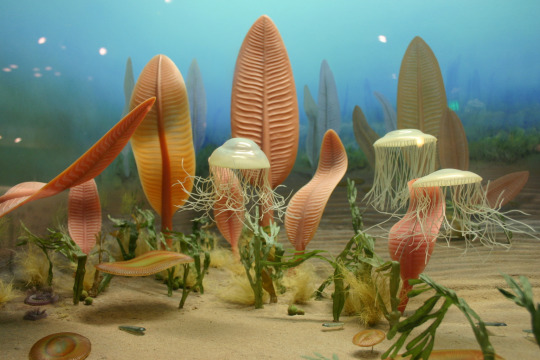
* Genus: A genus (plural genera) is a taxonomic rank used in the biological classification of living and fossil organisms, as well as viruses,in biology. In the hierarchy of biological classification, genus comes above species and below family.
**Holotype: A holotype is a single physical example (or illustration) of an organism, known to have been used when the species was formally described.
***Sessile: Sessility is the biological property of an organism describing its lack of a means of self-locomotion.
Please feel free to DM me if you have any questions.
4 notes
·
View notes
Note
We didn't start the fire prehistory: (I don't know enough dinosaur names I'm so sorry I'm such a fake fan) we didn't start the fire
stromatolites trilobites wiwaxia opabinia burgess shale what the hale anomalocaris plenocaris naraoia waptia WE DIDNT START THE CAMBRIAN EXPLOSION
8 notes
·
View notes
Text
translators note: waptia-tan's name in japanese is just ワプタン but that would have an unfortunate association if i just directly tled that
5 notes
·
View notes
Text
Im pretty sure I got possessed by the ghost of an anomalocaris last night and I couldnt sleep until I made this pattern so, enjoy,,, some,.,, cambrian shrimps

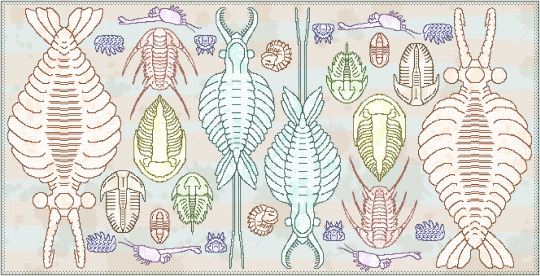
269 notes
·
View notes
Photo
[Image Description: Three screenshots from Spore of arthropods from the Cambrian period. The first is an orange aggania/peytoia. It has a small, cylindrical body ending in a pint at the back. It has two sharp pincer like appendages coming from the front, and an eye on either side of its body. It also has fan-like lobes on the side of its body.
The second image is of a blue opabinia. It has a long segmented body ending in a fan tail, with fan-like lobes on the side of its body. It has five eyes on the front of its head, and a proboscus below its head.
The third image is of a beige waptia. It looks very similar to a modern shrimp. /End ID]



peace and love on earth
#please let me know if I got anything wrong!!#or if it can be improved in any way#I tried my best on this one but it was harder bc I’m not super familiar with these lil guys#and I didn’t know how much detail to go into or how to even describe some parts#I just know if you told me simply this is a peytoia I’d be breaking bad meme jesse what the fuck are you talking about#image described
5K notes
·
View notes
Photo

Synophalos xynos, a shrimp-like arthropod from the Early Cambrian of China (~515 mya). Thought to be closely related to stem-crustaceans like Waptia, it was about 2cm long (0.75″) and had a bivalved carapace with a segmented body ending in a forked tail.
Unlike any other known arthropods, however, it formed long “conga line” chains of up to twenty individuals, with the tail of each animal locking securely into the shell of the next. The function of the these chains is unknown, although suggestions include some sort of mating behavior, migration, or defense against predators.
Only one specimen was found completely on its own, and its slightly longer carapace suggests it may represent a different solitary life stage of these strange little creatures.
#science illustration#paleontology#paleoart#palaeob#synophalos#waptiidae#stem-crustacean#crustaceomorpha#arthropod#cambrian explosion#art#conga shrimp
1K notes
·
View notes
Link
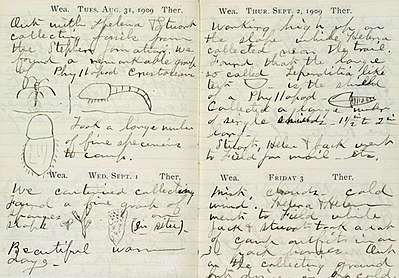
Biomimicry
Cuaderno de campo
de Charles D. Walcott (del 31 de agosto al 3 de septiembre de 1909) detallando el descubrimiento de los fósiles del
Esquisto de Burgess
. Hay tres artrópodos dibujados en la entrada del 31 de agosto –
Marrella, Waptia y Naraoia [16] http://recursos.normalpopayan.edu.co:8983/wikipedia_es_all_2017-08/A/Waptia.html
https://www.wikiwand.com/ja/%E3%83%AF%E3%83%97%E3%83%86%E3%82%A3%E3%82%A2
https://ca.wikipedia.org/wiki/Trilobits

via https://naturalhistory.si.edu/education/teaching-resources/life-science/early-life-earth-animal-origins
https://naturalhistory.si.edu/research/paleobiology
https://www.livescience.com/50458-oldest-neanderthal-dna-found.html
Por primera vez se ha recuperado material proteínico de una especie humana que vivió en Europa hace unos 800.000 años #HomoAntecessor
https://www.nature.com/articles/s41586-020-2153-8.epdf
https://twitter.com/nature/status/1245684159554695169
https://objecteiespai.tumblr.com/post/612151877718704128/organoge-residus-part-s%C3%B2lida-ossos-part
youtube
0 notes